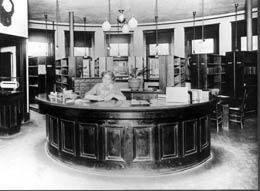
The reference desk or information desk of a library is a public service counter where professional librarians provide library users with direction to library materials, advice on library collections and services, and expertise on multiple kinds of information from multiple sources.
Interlibrary loan is a service that enables patrons of one library to borrow physical materials and receive electronic documents that are held by another library. The service expands library patrons' access to resources beyond their local library's holdings, serving as "an integral element of collection development" for libraries.

Digitization is the process of converting information into a digital format. The result is the representation of an object, image, sound, document, or signal obtained by generating a series of numbers that describe a discrete set of points or samples. The result is called digital representation or, more specifically, a digital image, for the object, and digital form, for the signal. In modern practice, the digitized data is in the form of binary numbers, which facilitates processing by digital computers and other operations, but digitizing simply means "the conversion of analog source material into a numerical format"; the decimal or any other number system can be used instead.
Landsbókasafn Íslands – Háskólabókasafn is the national library of Iceland which also functions as the university library of the University of Iceland. The library was established on December 1, 1994, in Reykjavík, Iceland, with the merger of the former national library, Landsbókasafn Íslands, and the university library. It is the largest library in Iceland with about one million items in various collections. The library's largest collection is the national collection containing almost all written works published in Iceland and items related to Iceland published elsewhere. The library is the main legal deposit library in Iceland. The library also has a large manuscript collection with mostly early modern and modern manuscripts, and a collection of published Icelandic music and other audio. The library houses the largest academic collection in Iceland, most of which can be borrowed for off-site use by holders of library cards. University students get library cards for free, but anyone can acquire a card for a small fee. The library is open for public access.
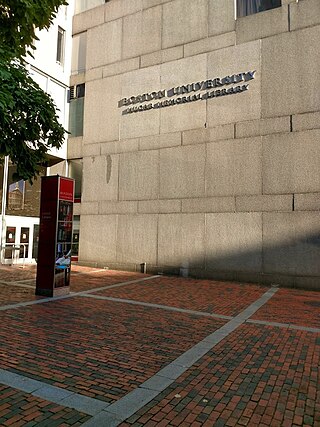
The Mugar Memorial Library is the primary library for study, teaching, and research in the humanities and social sciences for Boston University. It was opened in 1966. Stephen P. Mugar, an Armenian immigrant who was successful in the grocery business, provided the naming gift to commemorate his parents. Mugar's entrance carries an inscription from Stephen honoring his parents.
In coming to America from Armenia my parents opened the door of Freedom to me. America's public schools & libraries opened my eyes to the unlimited opportunity in this great land, as well as the privileges and obligations of citizenship. May this library serve over the years as a similar inspiration to all who use it. In memory of my father and mother Sarkis and Vosgitel Mugar. By their grateful son
– Stephen P. Mugar –
Library collection development is the process of systematically building the collection of a particular library to meet the information needs of the library users in a timely and economical manner using information resources locally held as well as resources from other organizations. "According to is a dynamic self perpetuation cycle or process and consists six definable stages namely,community analysis, selection policies, selection, acquisition, weeding and evaluation.
The University of California operates the largest academic library system in the world. It manages more than 40.8 million print volumes in 100 libraries on ten campuses. The purpose of these libraries is to assist research and instruction on the University of California campuses. While each campus library is separate, they share facilities for storage, computerized indexing, digital libraries and management.
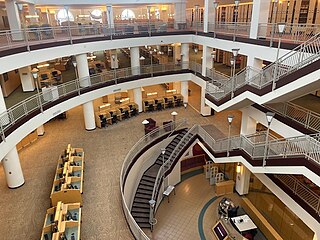
The Central Michigan University Libraries consists of the two libraries which support Central Michigan University, a public university in Mount Pleasant, Michigan. The CMU Libraries meets the research, information, and study needs of the students, faculty, and staff of the university, as well as researchers outside the university community. The library building is named after Charles V. Park, who was the library director at CMU from 1931 through 1957.
A library technician is a library and information professional in charge of the day-to-day functions of a library and assisting libraries in the acquisition, preparation, and organization of information. They also assist patrons in finding information. The widespread use of computerized information storage and retrieval systems has resulted in library technicians assisting in the handling of technical services. Especially in small libraries, a library technician may be the only person staffing the library. In larger libraries, they may help run certain departments and supervise library clerks, aides, and volunteers. Because libraries are increasingly using new technologies, the role of the library technician is expanding and evolving accordingly.
Library technical services are the ongoing maintenance activities of a library's collection, including the three broad areas of collection development, cataloging, and processing. Technical services are the infrastructure that enable the user's experience of many library services and are typically performed "behind the scenes."
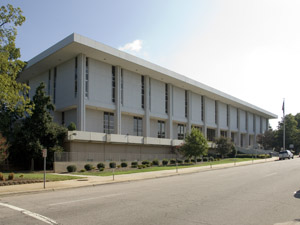
The State Library of North Carolina is an institution which serves North Carolina libraries, state government employees, genealogists, and the citizens of North Carolina. The library is the main depository for North Carolina state publications and serves the needs of North Carolina government agencies and state government employees by providing access to information resources that are vital to public decision-making and economic development.

In conservation, library and archival science, preservation is a set of preventive conservation activities aimed at prolonging the life of a record, book, or object while making as few changes as possible. Preservation activities vary widely and may include monitoring the condition of items, maintaining the temperature and humidity in collection storage areas, writing a plan in case of emergencies, digitizing items, writing relevant metadata, and increasing accessibility. Preservation, in this definition, is practiced in a library or an archive by a conservator, librarian, archivist, or other professional when they perceive a collection or record is in need of maintenance.
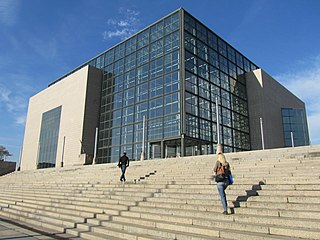
National and University Library in Zagreb (NSK) is the national library of Croatia and central library of the University of Zagreb.
Preservation survey is the process of collecting and analyzing data about the physical condition of library materials.

Mold control and prevention is a conservation activity that is performed in libraries and archives to protect books, documents and other materials from deterioration caused by mold growth. Mold prevention consists of different methods, such as chemical treatments, careful environmental control, and manual cleaning. Preservationists use one or a combination of these methods to combat mold spores in library and archival collections.
An inventory is an itemized list of objects that a museum has accessioned or received via loan(s) and must be physically located by an examiner. A complete, one-hundred percent inventory, or a random inventory of the collection should be carried out periodically to ensure the museum is operating under best practices and for security purposes. The museum is legally responsible and ethically obligated for the maintenance of up-to-date information detailing the location of all objects within the collection, including loaned items and objects that have yet to be accessioned; this is stipulated by many museum associations, including the American Association of Museums.

Keyes DeWitt Metcalf was an American librarian. He has been identified as one of the 100 most important leaders in librarianship by the journal American Libraries. In a career spanning over 75 years, he worked in various roles at the New York Public Library and served as the director of the Harvard University library system. He was known for his expertise in planning and designing research libraries.

The Younes and Soraya Nazarian Library is a central academic library of the University of Haifa, and one of the largest in Israel. It is also one of the most progressive Israeli libraries in terms of service, collection, physical space, and library information systems.

The conservation and restoration of books, manuscripts, documents, and ephemera is an activity dedicated to extending the life of items of historical and personal value made primarily from paper, parchment, and leather. When applied to cultural heritage, conservation activities are generally undertaken by a conservator. The primary goal of conservation is to extend the lifespan of the object as well as maintaining its integrity by keeping all additions reversible. Conservation of books and paper involves techniques of bookbinding, restoration, paper chemistry, and other material technologies including preservation and archival techniques.

In library science and architecture, a stack or bookstack is a book storage area, as opposed to a reading area. More specifically, this term refers to a narrow-aisled, multilevel system of iron or steel shelving that evolved in the 19th century to meet increasing demands for storage space. An "open-stack" library allows its patrons to enter the stacks to browse for themselves; "closed stacks" means library staff retrieve books for patrons on request.











